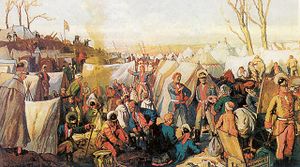التجريدة الفارسية 1796
| الحملة الفارسية 1796 | |||||||
|---|---|---|---|---|---|---|---|
| جزء من الحروب الروسية الفارسية | |||||||
 جنود كاثرين الثانية، بريشة ألكسندر بنوا | |||||||
| |||||||
| المتحاربون | |||||||
|
|
| ||||||
| القادة والزعماء | |||||||
|
|
| ||||||
| القوى | |||||||
| 50,000[1] (other estimates suggest 30,000-40,000)[2] |
Tofangchi Musketeers Royal Regiment of Mohammad Khan Northern Town Watch | ||||||
| الضحايا والخسائر | |||||||
| 2,150 رجل | غير معروف | ||||||
التجريدة الفارسية في 1796 قامت بها روسيا في عهد كاثرين الكبرى ضد فارس، رداً على الهجوم الفارسي على جورجيا. وتشكل تلك التجريدة مع توسع بطرس الأكبر في فارس، يشكلان جملة الحروب الروسية الفارسية في القرن الثامن عشر والتي لم يترتب عليها أية آثار باقية لأي من الطرفين.
تم في سنة 1783 توقيع اتفاقية جوارجيوس التي قضت بانتقال جورجيا التي كانت تتعرض للاضطهاد الديني وغزوات العثمانيين والفرس الى حماية روسيا. وقامت ايران باجتياح عاصمة جورجيا تبليسي التي دمرت ونهبت، وترأس الحملة العسكرية ضدها أغا محمد خان مؤسس السلالة الايرانية الحاكمة الجديدة الذي سعى الى استعادة سيطرته على جورجيا.
كان الملك الجورجي قد وجه مراراً طلبات الى روسيا لتقديم المساعدة له. وقامت روسيا في أبريل عام 1796 بتوجيه فيلق قزوين برئاسة ڤالريان زوبوڤ من مدينة قزلار عبر داغستان كلها إلى الأقاليم الأذربيجانية في إيران. واستولى الروس على قلعة دربنت، ثم دخلوا قبة وباكو دون أن يواجهوا أية مقاومة. لكن روسيا شهدت تغيرات بعد تربع القيصر پاڤل الأول على العرش الروسي، الامر الذي ادى الى انسحاب القوات الروسية من جنوب القوقاز في ديسمبر عام 1796.
The last decades of the 18th century were marked by continual strife between rival claimants to the Peacock Throne. Catherine the Great of روسيا took advantage of the disorder to consolidate her control over the weak polities of the Caucasus. The kingdom of Georgia became a Russian protectorate in 1783, when Erekle II signed the Treaty of Georgievsk, whereby the Empress promised to defend him in case of the Iranian attack. The shamkhals of Tarki followed the lead and accepted Russian protection three years later.
With the enthronement of Agha Mohammad Khan as Shah of Persia in 1794 the political climate changed. He put an end to the period of dynastic strife and proceeded to strengthen the hold of the Caucasus by ravaging Georgia and reducing its capital Tbilisi to a pile of ashes in 1795. Belatedly, Catherine II determined to mount a punitive expedition against the Shah.
Although it was widely expected that a 13,000-strong Russian corps would be led by a seasoned general (Gudovich), the Empress followed the advice of her lover, Prince Zubov, and entrusted the command to his youthful brother, Count Valerian Zubov. The Russian troops set out from Kizlyar in April 1796 and stormed the key fortress of Derbent on 10 May. The event was glorified by the court poet Derzhavin in his famous ode; he was later to comment bitterly on Zubov's inglorious return from the expedition in another remarkable poem.
By mid-June, Zubov's troops overran without any resistance most of the territory of modern day Azerbaijan, including three principal cities — باكو، شماخا وGanja. By November, they were stationed at the confluence of the Araks and Kura Rivers, poised to attack mainland Iran.
It was in that month that the Empress of Russia died and her successor Paul, who detested the Zubovs and had other plans for the army, ordered the troops to retreat back to Russia. This reversal aroused the frustration and enmity of the powerful Zubovs and other officers who took part in the campaign: many of them would be among the conspirators who arranged Paul's murder five years later.
. . . . . . . . . . . . . . . . . . . . . . . . . . . . . . . . . . . . . . . . . . . . . . . . . . . . . . . . . . . . . . . . . . . . . . . . . . . . . . . . . . . . . . . . . . . . . . . . . . . . . . . . . . . . . . . . . . . . . . . . . . . . . . . . . . . . . . . . . . . . . . . . . . . . . . . . . . . . . . . . . . . . . . . .
انظر أيضا
المصادر
- Gen. V.A. Potto. The Caucasian Wars of Russia from the 16th century onward. Volumes 1-5. SPb, 1885-86, reprinted in 2006. ISBN 5-9524-2107-5.
وصلات خارجية
- نزاعات 1796
- الحروب الروسية الفارسية
- تاريخ أذربيجان
- التاريخ العسكري لجورجيا
- معارك الأسرة القاجارية
- حروب أهلية إيرانية
- 1796 في أوروپا
- القرن 18 في الامبراطورية الروسية
- القرن 18 في إيران
- القرن 18 في أذربيجان
- القرن 18 في جورجيا
- Wars involving the Qajar dynasty
- يكاترينا الثانية من روسيا
- تاريخ داغستان
- History of the Caucasus under the Russian Empire
- غزو إيران
- Invasions by Russia